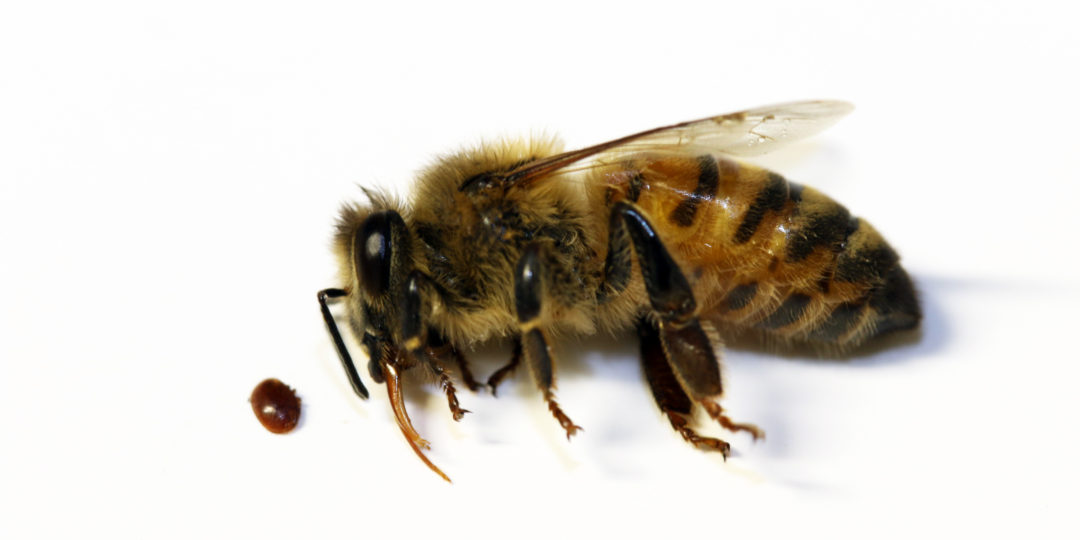Taking Notes from Survivor Populations: Fighting Varroa
by Victoria Rose

With cold months approaching, beekeepers are preparing their hives to overwinter. This includes fighting off parasitic varroa mite infestations, which often lead to honeybee colony deaths from late fall to early spring. A 2016 USDA survey reports that among honeybee management operations of both greater and less than five colonies, varroa mite infestation is one of the top stressors for beekeepers in the United States. If managed hives infected with varroa are left untreated, they frequently die within one to two years. As a result, chemical and manual mitigation methods are used to eliminate varroa from their hives with varying success. For example, using miticides to kill varroa may help the mites develop resistance, thus making future elimination more difficult. However, a recent study of wild honeybee colonies in New York’s Arnot Forest suggests that a long-term coexistence with varroa mites free of human intervention is possible.
Wild Honeybee Colonies with Varroa
The study contradicts the common belief that wild, unmanaged honeybee hives have been eliminated since the introduction of the varroa mite to the United States in the 1980s. A prevalence of self sustaining wild honeybee colonies in New York’s Arnot Forest is revealed, despite being infected with varroa. Genetic analysis of these wild colonies suggests that they are unrelated to swarms from surrounding apiaries. The study, lead in part by Cornell University’s Thomas D. Seeley, aims to understand the genetic and environmental factors that allow these wild colonies to independently survive pathogens without human intervention. The findings are a hopeful foundation for improved beekeeping practices in the future.
Though the wild colonies were found to still be of European origin, they differ in genetic makeup from the honeybees escaped from the hives of English settlers in the 1600s. These bees are self sustaining and consistent in population, while the numbers of managed honeybee colonies in Europe and North America continue to decline. The study uses these differences as a foundation to further investigate the ways in which varroa infestations can better be managed by exploring the potential environmental factors leading to their survival. Possible factors are listed below:
Natural Selection:
The lack of human intervention drives selection for disease resistance. Managed hives are often treated with pesticides and antibiotics, which impedes this process.
Vertical Transmission:
Wild colonies live far enough apart from each other that mites are only transmitted from parent colony to offspring colony through swarming, thus breeding avirulent mites. When host bees stay healthy, parasitic mites are able to continue spreading to new colonies. Managed colonies are often crowded in apiaries, so that infected bees may enter neighboring hives and transmit the mites to unresistant colonies so that a sustainable host-parasite relationship is never established.
Colony Size:
In the Arnot Forest, wild colonies live in hives 25%-50% smaller than those of beekeepers. Varroa mites reproduce in the brood cells of honeybee hives, and smaller hives contain fewer brood cells, which provides less space for this process.
Higher Swarming Rate:
The small size of wild colony hives also promotes higher rates of swarming. Seeley notes that when a colony swarms, it loses 40%-70% of it’s worker bee population. Around 50% of mites live on adult bees, so swarming rids colonies of about 20-35% of its mites. During swarming, the colony loses its queen. The process of hatching a new queen takes about 1-3 weeks. During this queenless period, the mites have no brood in which to reproduce, which suggests “intensive mite removal”.
Finally, the study uses these environmental factors to analyze the ways in which current beekeeping practices may be conducive to fatally spreading parasites and pathogens. Hopefully, better management methods can be explored in response. Practices such as using miticides, hosting large colonies, crowding colonies in large apiaries, and moving colonies frequently are common, but may be harmful. They have the potential to prevent the natural selection of pathogen resistant bees, impede necessary swarming, and promote the horizontal transmission of varroa between susceptible colonies. While further investigation is needed, the study serves as a starting point for developing ways to counteract one of the most prevalent stressors in beekeeping across continents.
Organic Beekeeping
As part of a natural approach to hive management, beekeepers employing “organic” practices do not treat their colonies with miticides or any other chemicals to kill varroa mites. The unique genetic makeup of the wild honeybees in the Arnot forest lend credibility to the idea that this promotes natural selection. Our partners at The Best Bees Company use this organic beekeeping approach in hope of promoting natural development of equilibrium between bees and mites. Beekeepers can spread this adaptation by simulating swarms, and enhance the conditions that may allow resistant survivor colonies to thrive.[/vc_column_text][vc_column_text]For anyone interested in learning more, the full paper is available in the journal Apidologie for free online from SpringerLink.
For more statistics from the USDA on honeybee colonies, see the full 2016 report here.
Victoria Rose is a first year beekeeper. A recent Boston University graduate, Victoria works with both The Best Bees Company as a field beekeeper and in our lab, contributing to our ongoing research efforts concerning honeybee health.